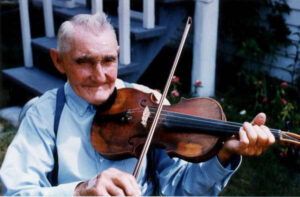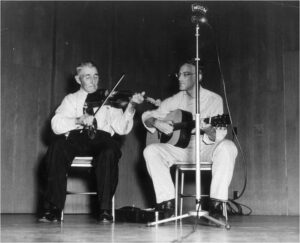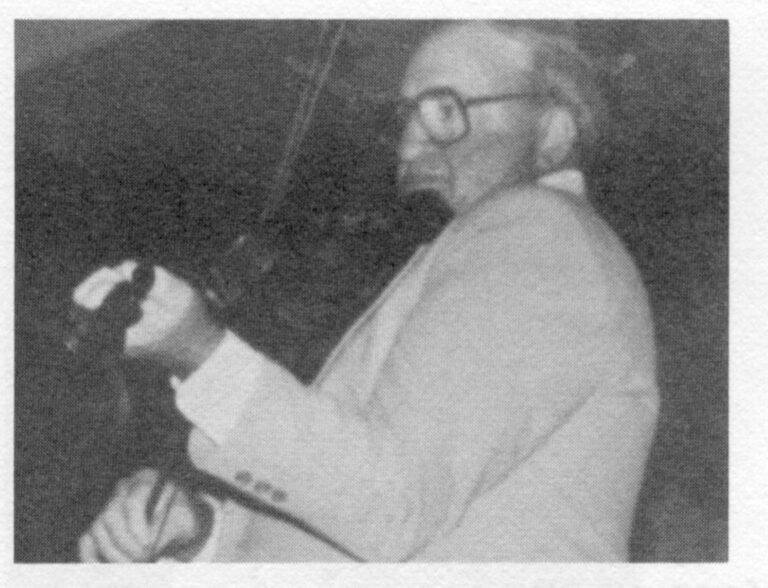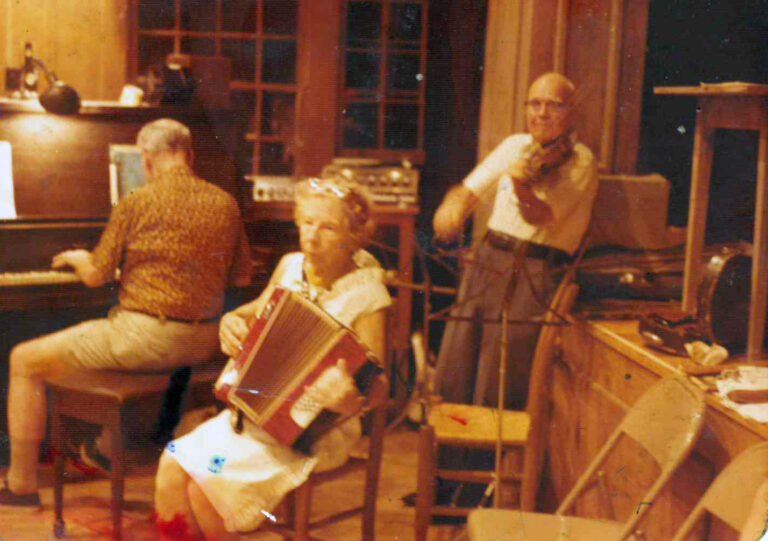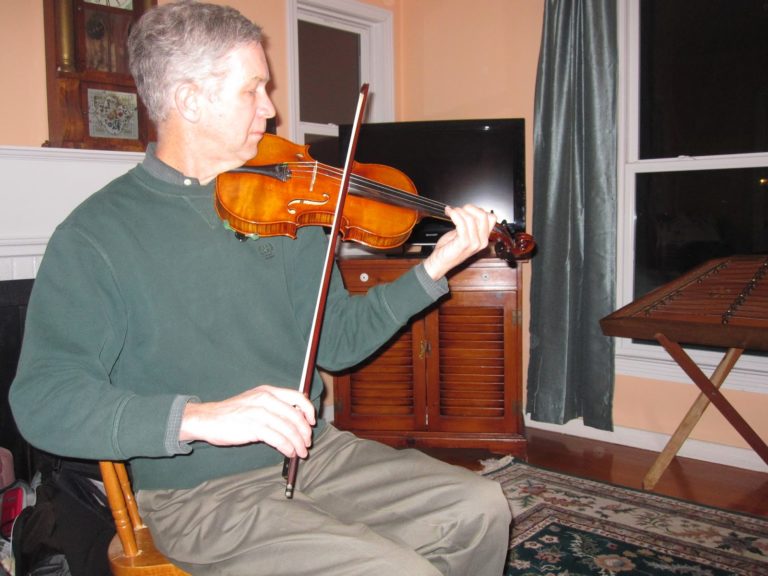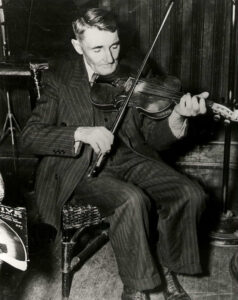
Patrick Bonner at the King Strang Hotel, Beaver Island.
Patrick Bonner: History and Interviews
(This history and interview collection presented through the hard work of fiddler and historian Glenn Hendrix. Many thanks!)
Interviews with Patrick Bonner
Beaver Island, Michigan
[Ivan Walton interviewed and recorded Patrick Bonner between the 1930?s through 1962. Glenn Hendrix compiled and editted these interviews. The interviews and transcriptions of Bonner?s fiddle tunes are published in An Island of Fiddlers, Fiddle Tunes of Patrick Bonner, Beaver Island, Michigan, compiled by Glenn Hendrix (2008)]
Visitors to County Donegal in Ireland may hear the Irish speak of ?an island of fiddlers in Lake Michigan.? That is Beaver Island, which is the largest of a group of islands in northern Lake Michigan. Beaver Island was settled by immigrants from the west coast of Ireland. Two of these early settlers were Captain ?Black? John Bonner and his wife Sophie. Their son, Patrick Bonner was born in 1882 and was a talented fiddler.
Bonner was part of Michigan?s rich fiddling tradition. Bonners? fiddling was a unique blend of Irish and Michigan styles. He includes some decorations characteristic of fiddling in County Donegal and simpler rhythms of Michigan?s dance fiddlers. Bonner?s tunes reflect this mixed origin. Many of his tunes were brought from Donegal by Irish settlers of the Island. He learned other tunes in lumber camps, on schooners that sailed the Great Lakes or from radios and recordings. Some of the tunes were composed by Island fiddlers, and Bonner probably composed some himself. Bonner played his music for dances and house parties for many years, and kept playing after newer styles became more popular.
Irish Settlement of Beaver Island
Beaver Island was first settled by the Anishinabeg?the people of the three fires (Ojibwa, Odawa and Potawatomi). European settlers, mostly French, Irish and Scottish, arrived in the early 1800s. Patrick Bonner?s parents were some of these early settlers. In 1848 a large group of Mormons settled on the Island and non-Mormon people left. A mob drove the Mormons off the Island in 1856 after the Mormon leader was murdered. This left the Island open to other settlers. Some of the previous Irish settlers, including Bonner?s parents, returned. Patrick?s father was ?Black? John Bonner, who was born on the island of Rutland in 1821and his mother was Sophia Harkins, born in 1839. Soon other settlers arrived from Ireland.
The Island provided many economic opportunities to Irish immigrants. Here they could own land, cut timber, farm, sail the lakes and fish?opportunities denied to them in an Ireland oppressed by greedy landlords and British rule. Fishing was excellent at the time. The Island also has an excellent natural harbor and was visited by many sailing vessels and steamers. Many Islanders worked providing wood fuel for early steamboats. A thriving Irish community developed on Beaver Island.
Patrick Bonner was born and lived his entire life on the Island. His parents owned a schooner and a small farm. Patrick was the youngest of nine children. Their first home was a log cabin. His neighbors were Irish (with the unlikely exception of an Estonian emigrant named Feodor Protar who lived across the road). Bonner worked various jobs logging, farming and sailing. He married Rose Boyle in 1915, and they had three children, John, Robert and Mary. Rose played piano with Bonner, but unfortunately she was never recorded.
Bonner?s music would be forgotten today but for the efforts of Ivan Walton. Walton was an English professor at the University of Michigan. He collected folk stories and music from all over the Great Lakes area. Walton first came to Beaver Island in the 1930?s and returned many times until he retired in 1962. Walton recorded some Island musicians, including singers Johnny Green, Mike O?Donnell, Dominick Gallagher, Helen Pischner and Patrick Bonner playing his fiddle.
During recording sessions, Pat would play a tune, then Walton would ask the name of the tune, where it came from and other questions. Pat spoke simply and eloquently of how he learned to play, other Island fiddlers, dancing, his violin and other topics.
Interviews with Patrick Bonner
This section is from Ivan Walton?s interviews with Pat Bonner. I edited this material quite a bit, and removed Walton?s questions and comments to make it readable. Due to the poor quality of the old recordings, I occasionally filled in missing words or phrases.
Patrick Bonner tells his story….
Learning to play the fiddle
“First fiddler I ever heard was Johnny Owen and of course I was only about four or five years old and they wouldn?t let me go over [to the dance]. By God, I sat up and stood at the door listening to them tunes, and I knew every one of them that he played. As long as they let me up out of bed. I could learn the tunes so quick in them days. Course I didn?t learn to play the violin then, I learned the tunes. I would know the tunes.”
“My brother had an old violin. He had that fiddle hung upstairs on a nail. He?d be out in the fields working. I used to get up on a chair. I?d lift it right up and take it down. I?d take it down and try it. Course I?d have it back there [when he got back]. So that?s how I learned to play.”
“That was a borrowed violin. He went away to the lakes and went away on our schooner…I never seen him for six years. But he wrote home and told them to give that fiddle back to the Boyles, Huey and Tommy and Peter. So they did, took that fiddle back. I liked the sound of that violin. I guess my mother might have told Tommy Boyle that. Well then there was a couple of years?three or four?I didn?t have no violin. It wasn?t long after I got one.”
“But anyhow I got my fiddle. I was 12 years old. I started playing fiddle then. A fellow named Henry Brady sailed [on our] schooner long ago. He came with my brother, who told him I liked to play the violin. So he had one. It wasn?t a very good one, but we bought it from him. So I learned to play. I was about 11 or 12 years old then.”
“[I got my next fiddle] from my brother-in-law. A Stradivarius. He got it up north someplace in a lumber camp. I don?t know [how it got there]. That?s the name on her. I?ve had this violin for over 60 years.”
“It don?t take me very long [to learn a tune] if I hear it. It takes me a little longer now than it used to. Years ago when I heard it first, well, that?s all I needed. Now I don?t pick it up so quick. You see, I?d go to bed and that tune would be ringing through my head all night while I was snoozing. And I?d know it in the morning. That sound would stay right with me. Course now days you know, I?m different. I couldn?t pick it up so quick now. I?ll be 70 in November. Born in eighty-two.”
“I don?t know much about music. I never took a music lesson in my life. Just picked it up by ear. I learned [keys] from organ players, piano players years ago. ?Where?s your last sound?? they?d say. And another fiddler my age?he took some lessons?and mostly that?s where I learned to play the key, you know if it was A, D, G, C or whatever it might be. Now you put a [music] notebook in front of me and I couldn?t tell that from Chinese letters.”
“Gosh, I haven?t any idea [how many tunes I know]. I suppose a thousand altogether. I?ve got as many without names as I have with names. Them tunes are all dead and buried 50 years or more. Nobody in the world I suppose knows them.”
Dances and Balls
“Oh yes, I used to play for dances quite a bit. [They were] mostly in the dance halls. In later years it was all in homes. The Fourth of July or sometimes they?d have them in the halls, or New Year?s. They used to have a lot of dances, balls, country dances. In the winter time we used to dance those balls where they?d eat and dance all night. Lots of fun. At least 10 or 11 a year. We?d have three or four every winter. The balls. Then we had country dances. There?d be one or two every week throughout the summer months. We?d play ?til daylight. We didn?t get tired in them days. I do now?.”
“I played for dances over 60 years. I played for dances when I was 14 or 15 years old. The last five I haven?t played so much. They dance with the juke boxes and this rock and roll they dance to mostly. There?s some of the old timers comes. They get together and come and get me to play for them. I?ll tell you last Christmas at the school house there was quite a gathering. The last one I played for in the country was at the school house down across from Frank O?Donnell?s. Nobody in the country to dance; they?re all gone. And people in town, they all dance to this juke box stuff. [Nobody else on the island] could play for a dance. There ain?t any of them practicing, the old music anyway. “
Other Island Fiddlers
“Oh yes, there were [many fiddlers on the island]. There was three in one house. There was Lanty McCafferty [Bonner?s brother-in-law], and Francie McCafferty, and Peter McCafferty. They were three brothers could play. And even Middie Karl and Charlie Karl could play. And there was Peter Boyle and Hughie Boyle. Sam Baker could play. Mike Mooney could play. And there was two fiddlers in Gallaghers. Neil Gallagher?s brother and Owen Gallagher could play. A dozen more could play a little. Now in the McCauleys there was Johnny McCauley could play, there was a fellow called Paddy McCauley could play. There were all young men when I was boy. That?s where I got them [the tunes] all, mostly. Only what I?d get now and then from a radio or phonograph or something like that.”
“They didn?t play as much [as I] because there was more of them. Now days I got to do it alone. I?m the only fiddler that?s left, I guess [that plays] the old time stuff. When the radios come or the pop machines, the victrolas, that spoiled everything. They let the machine do it, not play themselves. Nobody learned to play.”
Origins of the Tunes
“Well, I picked [The Shores of Lake Erie] up when the phonographs came out first. Some fiddler in town or downtown, somebody had a phonograph, so I picked it up and learned it. “
“I learned [The Hare Was in the Corn] long ago from some of them old fiddlers, I can?t recall. In later years we didn?t know the names of tunes. So an Irish fellow came out ?name of Dan O?Donnell – and he played it on the accordion. I said ‘I play that tune on the fiddle, but I don?t know the name of it.’ ‘Oh,’ he said, ‘that?s The Hare was in the Corn.’ He learned it in Ireland. [The tunes I play] are mostly all Irish.”
“Well, I don?t know [how that tune got its name]. The Irish people came out from Ireland, some of them that would compose tunes. They called [that one] Gull Island. I learned it from McCauley. He was about the first fiddler I ever learned from. I leaned that when I was 17 I expect. And other fiddlers could play it. Lanty could play it. Neil Gallagher could play it. Many more I suppose too. “
“There was another tune that somebody else had for Gull Island. See I played Gull Island and then there was another tune Katcheline said was Gull Island. The other fiddlers had it right, but she said it was something else. [She was] an old lady that used to lilt all those tunes. She was a great musician for singing and lilting tunes. She would lilt them tunes, them old Irish reels. Her last name was McCauley. She was an O?Donnell as a girl, then she was married to John McCauley. She was born in Ireland. “
“Well this one I learned from Lanty McCafferty?he played it. [He got it] from an older fiddler than him again, an old fellow called Rouseau I guess. He used to come here to the Island. I never seen him. He was dead before I was born.”
“God, I don?t know [the name of that one]. I learned it long ago. I learned it. I never the knew the name of it, I just heard it. See I never had no books to learn from.”
“[Saddle on the Mare] must have come from Ireland because I heard an old Irishman sing it, and I heard the fiddlers play it. So I learned it. Oh, it must have been fully 55 or 56 years ago. “
Left to right: Pat Bonner in 1966 (?) / Pat Bonner with Alan Lomax / Bonner at the King Strang Hotel

